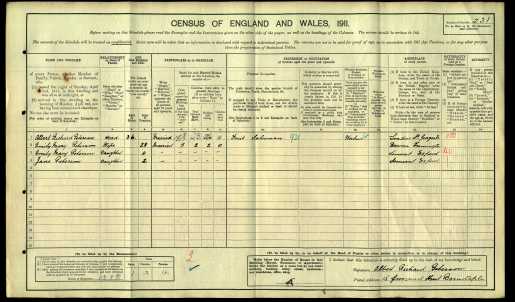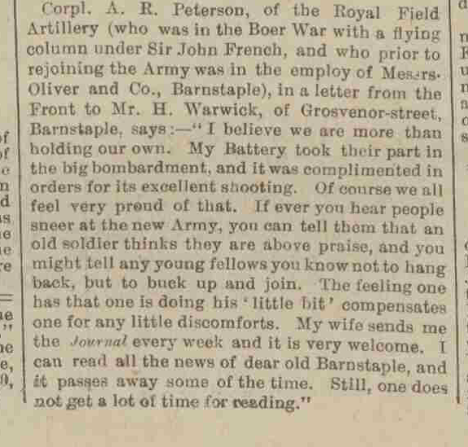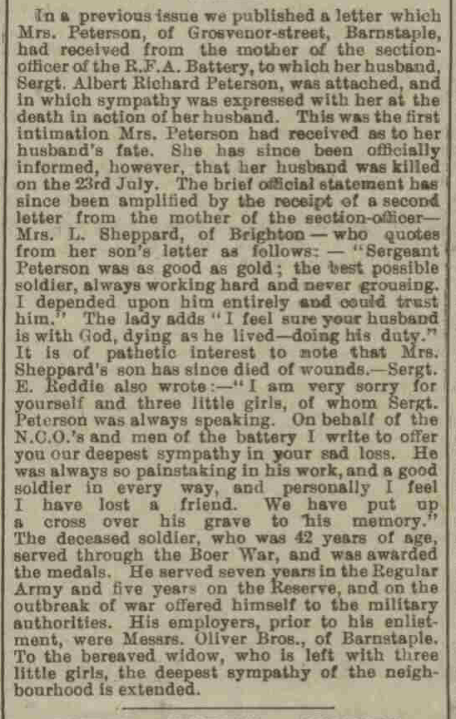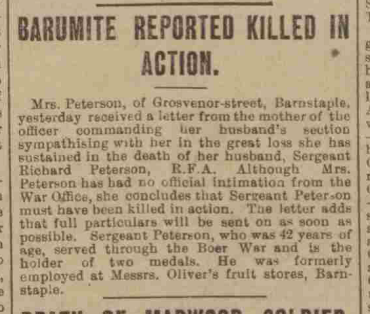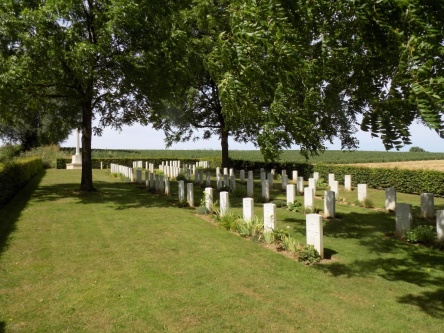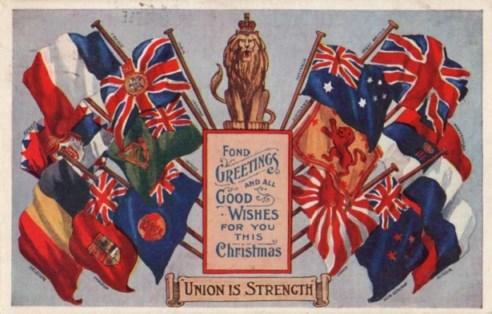
This month we take a look at a selection of the stories and adverts that appeared in the local newspapers over Christmas and New Year 1916/17.
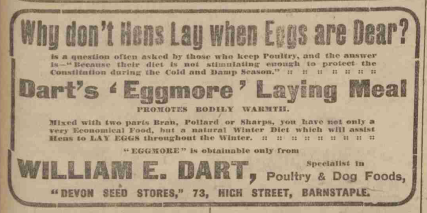
William Dart of the Devon Seed Stores, 73 High Street, was advocating the use of his “Eggmore laying meal” to encourage hens to lay during the cold damp months of winter when eggs were scarce.
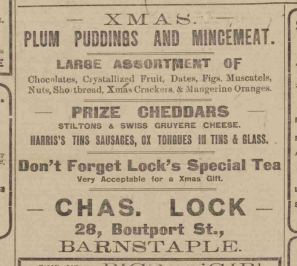 Your Christmas fare could be obtained at a number of local businesses. Plum puddings and mincemeat, a large assortment of chocolates and crystallized fruit, prize cheddars, stiltons and swiss gruyere, ox tongues in tins and glass, could all be found at Chas Lock of 28 Boutport Street. “Home-made sausages, brawn and lard of the highest quality” could be found at A Frayne and Son, 34 Bear Street, pork purveyors, ham and bacon curers.
Your Christmas fare could be obtained at a number of local businesses. Plum puddings and mincemeat, a large assortment of chocolates and crystallized fruit, prize cheddars, stiltons and swiss gruyere, ox tongues in tins and glass, could all be found at Chas Lock of 28 Boutport Street. “Home-made sausages, brawn and lard of the highest quality” could be found at A Frayne and Son, 34 Bear Street, pork purveyors, ham and bacon curers.
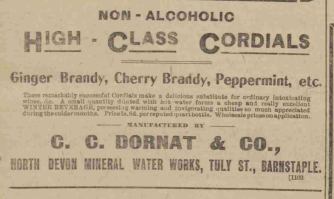 CC Dornat, North Devon Mineral Works, Tuly Street, Barnstaple offered “non-alcoholic high class cordials… a delicious substitute for ordinary intoxicating wines &c… possessing warming and invigorating qualities”. However, if you had “that creepy chilly feeling” or were feeling “stuffy in the head” you could obtain the Barum Cure from Frank Dyson, chemist of 26 Joy Street, Barnstaple.
CC Dornat, North Devon Mineral Works, Tuly Street, Barnstaple offered “non-alcoholic high class cordials… a delicious substitute for ordinary intoxicating wines &c… possessing warming and invigorating qualities”. However, if you had “that creepy chilly feeling” or were feeling “stuffy in the head” you could obtain the Barum Cure from Frank Dyson, chemist of 26 Joy Street, Barnstaple.
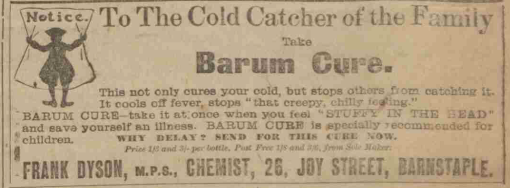
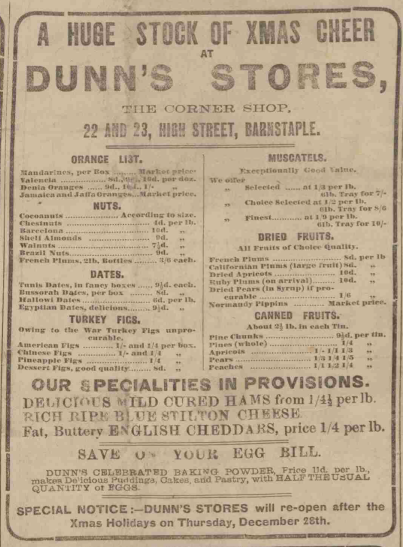
Dunn’s Stores, at 22 and 23 High Street, offered “a huge stock of Xmas cheer”- the supply of Valencia and Jamaica oranges, Egyptian dates and Californian plums seemingly unaffected by the continuing hostilities although it was said that “owing to the War, Turkey figs (were) unprocurable”.
Difficulties of supply were also mentioned by W Dalling, tobacconist, of 11 High Street, who acknowledged that “in spite of present difficulties and shortage of supplies” that he could offer a selection PRACTICALLY EQUAL to his pre-war standard” of “the most acceptable and useful Xmas presents”.
W Manaton of Braunton also sought to reassure customers that he could “still supply pre-war indigo suitings” which when “made up with linings of a quality not now obtainable, enable us to keep up our old quality”.

Frank Rowe of Barnstaple and Braunton announced that “Father Christmas has arrived” with sacks and sacks of dolls and toys” on offer. Hellier’s Novelty Stores of 88 High Street suggested that we “throw off dull care and let us have a pleasant Xmas with our little ones” – by way of a trip to see all the “pretty and interesting things”at their shop. In the small ads Hellier’s also advised that you “always take an electric pocket lamp with you these dark nights- to be had… all prices” at their stores, of course.
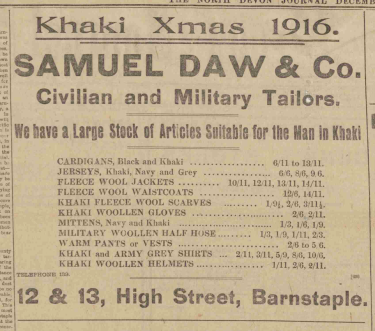 Samuel Daw of 12 and 13 High Street suggested a Khaki Xmas, and the purchase of “military woollen half hose” or “warm pants or vests” among the ideas for “the man in khaki”. Walter J Thomas of 48 Boutport Street commended “something useful in these times”for men in the Services and a similar choice, including “sleeping helmets, mufflers, (and) spencers”, and sustenance in the form of Genoa Cake from Barnstaple Bakeries was mooted as”an ideal present for our boys at the Front”
Samuel Daw of 12 and 13 High Street suggested a Khaki Xmas, and the purchase of “military woollen half hose” or “warm pants or vests” among the ideas for “the man in khaki”. Walter J Thomas of 48 Boutport Street commended “something useful in these times”for men in the Services and a similar choice, including “sleeping helmets, mufflers, (and) spencers”, and sustenance in the form of Genoa Cake from Barnstaple Bakeries was mooted as”an ideal present for our boys at the Front”
The Lynton and Barnstaple Railway announced a change in its timetable to accommodate the Christmas Market being held on the Thursday 21st December rather than the usual Friday, and a Sunday service for Christmas Day itself.
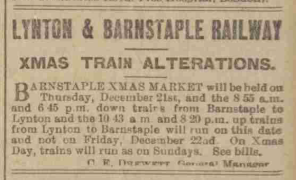
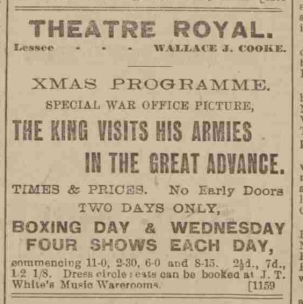 Entertainment on offer at the Theatre Royal consisted of the “special War Office picture – The King visits his armies in the Great Advance” four showings on Boxing Day and Wednesday.
Entertainment on offer at the Theatre Royal consisted of the “special War Office picture – The King visits his armies in the Great Advance” four showings on Boxing Day and Wednesday.
Those injured in the War were not forgotten, as a collection on behalf of Barnstaple War Supply Depot was to be made on Christmas Market Thursday, the depot having “established a fine record in making requisites for the wounded in the hospitals and in other directions”.
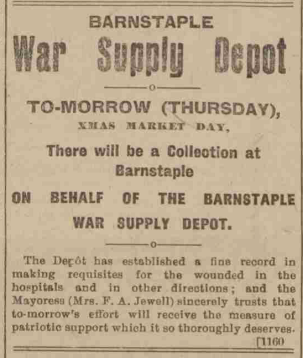 The daily cost of the War was now a staggering “£ 5,710,000 including £400,000 daily in advances to Allies”. The total expenditure of the War for the year was said to have been £1,950,000,000, £350,000,000 more than had been the Budget estimate. Mr Bonar Law pointed out that the armies could not be kept at their present strength indefinitely and that all that could be hoped for was that they would be “kept on a strong figure long enough to beat our enemies” – an estimated figure of an extra 1,000,000 men for 1916/17 bringing the total to 5,000,000 is quoted.
The daily cost of the War was now a staggering “£ 5,710,000 including £400,000 daily in advances to Allies”. The total expenditure of the War for the year was said to have been £1,950,000,000, £350,000,000 more than had been the Budget estimate. Mr Bonar Law pointed out that the armies could not be kept at their present strength indefinitely and that all that could be hoped for was that they would be “kept on a strong figure long enough to beat our enemies” – an estimated figure of an extra 1,000,000 men for 1916/17 bringing the total to 5,000,000 is quoted.
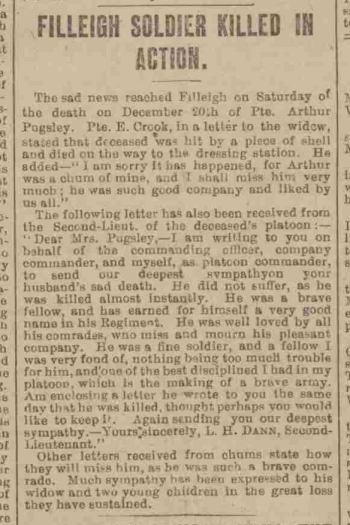 The effects of this mass mobilisation on families are illustrated by two brief articles. One records the death of 19 year old John Yeo, of Raleigh Park, at Aldershot, so probably in the Army, the fifth son of a family who had four sons in the Services. The other, a poignant note of sincere thanks by the three sons of the recently deceased FJ Tancock, neither of whom could attend their father’s funeral due to being on active service abroad.
The effects of this mass mobilisation on families are illustrated by two brief articles. One records the death of 19 year old John Yeo, of Raleigh Park, at Aldershot, so probably in the Army, the fifth son of a family who had four sons in the Services. The other, a poignant note of sincere thanks by the three sons of the recently deceased FJ Tancock, neither of whom could attend their father’s funeral due to being on active service abroad.
The sad news reached Filleigh of the death of Private Arthur Pugsley who had been hit by a piece of shell and died on the way to the dressing station. The platoon commander, writing to his widow, also enclosed a letter written to her on the day of his death.
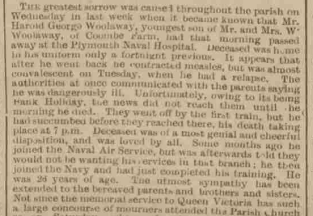 Another sad loss, to Chittlehampton, was of Harold Woolaway of Coombe farm, who had been home in uniform only a fortnight previously but contracted measles and died in the Naval Hospital at Plymouth.
Another sad loss, to Chittlehampton, was of Harold Woolaway of Coombe farm, who had been home in uniform only a fortnight previously but contracted measles and died in the Naval Hospital at Plymouth.
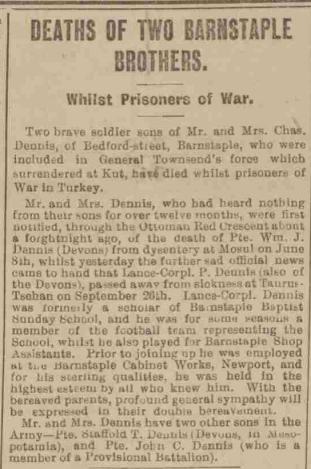
Mr and Mrs Charles Dennis of Bedford Street, who had heard nothing for over a year of their two sons, who had survived the siege of Kut and since been prisoners of war in Turkey, had heard in the last weeks that both had died from dysentery or sickness. They had two other sons in the Army, one of those in Mesopotamia.
Mr and Mrs E Berry of Carrington Terrace, already looking after their three grandchildren after their daughter’s death. had heard that their son-in-law was now suffering from malaria and heart disease in Alexandria. They too had three sons of their own in the Army.
The suicide of Mabel Vavasour Peek, 32 year old companion help from Ilfracombe, was put down to her “temporary insanity” having asphyxiated herself in the gas oven, her employer having found her lying on the scullery floor one morning after her breakfast in bed had not arrived, nor had any answer to her summoning bell. Miss Peek’s brother had just gone to the Front and she was said to have been worried that he would never come back.
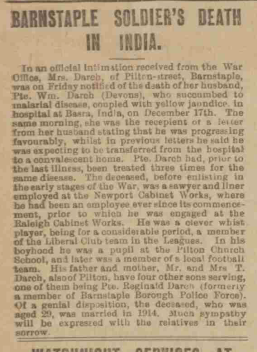 Mrs Darch of Pilton Street, heard of the death of her husband William from malarial disease and yellow jaundice in Basra. He had had the disease three times already and she had also received on the same morning, a letter from him saying that he was improving and to be transferred to a convalescent home. Aged 29 he had been married a few years but no children are mentioned. He did, however, have four other brothers serving.
Mrs Darch of Pilton Street, heard of the death of her husband William from malarial disease and yellow jaundice in Basra. He had had the disease three times already and she had also received on the same morning, a letter from him saying that he was improving and to be transferred to a convalescent home. Aged 29 he had been married a few years but no children are mentioned. He did, however, have four other brothers serving.
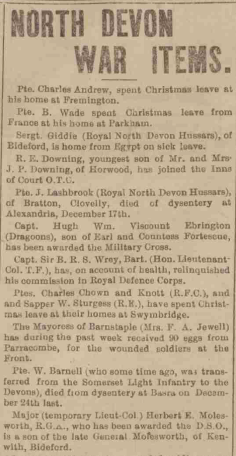
Deaths from dysentery at Alexandria and Basra were also recorded in the North Devon War Items column of the newspaper as well as other soldiers being home on sick or Christmas leave. The receipt of woollen goods from two women, and also eleven shirts and thirteen pairs of socks made by a Swymbridge (sic) working party, by the aforementioned Barnstaple War Supply Depot are also noted.
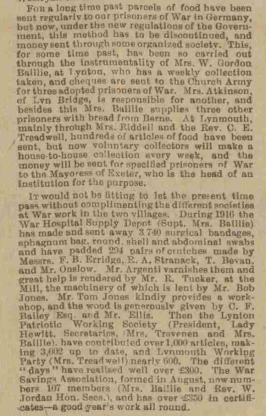
The War Supply Depot at Lynton and Lynmouth had contributed 294 pairs of crutches – made. varnished, and padded locally – and 3,740 bandages and swabs. The Lynton Patriotic Working Society and the Lynmouth Working Party were also making items to be sent overseas.
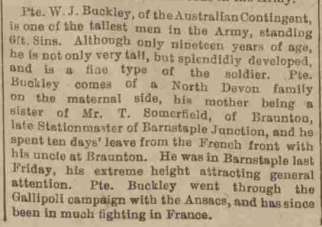 WJ Buckley, serving with the Australian contingent, had just spent ten days leave from the French front with an uncle in Braunton. Only 19 years of age, he stood at 6ft 8 in and was also “splendidly developed”, his “extreme height attracting general attention” when he had been in Barnstaple on the Friday.
WJ Buckley, serving with the Australian contingent, had just spent ten days leave from the French front with an uncle in Braunton. Only 19 years of age, he stood at 6ft 8 in and was also “splendidly developed”, his “extreme height attracting general attention” when he had been in Barnstaple on the Friday.
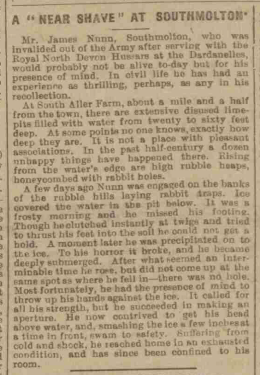 At home, a veteran of the Dardanelles, James Nunn of South Molton, who had been invalided out of service, had a narrow escape from drowning when he fell through the ice on a flooded lime pit at South Aller Farm after missing his footing while laying rabbit traps. “Suffering with cold and shock, he reached home in an exhausted condition, and has since been confined to his room”.
At home, a veteran of the Dardanelles, James Nunn of South Molton, who had been invalided out of service, had a narrow escape from drowning when he fell through the ice on a flooded lime pit at South Aller Farm after missing his footing while laying rabbit traps. “Suffering with cold and shock, he reached home in an exhausted condition, and has since been confined to his room”.
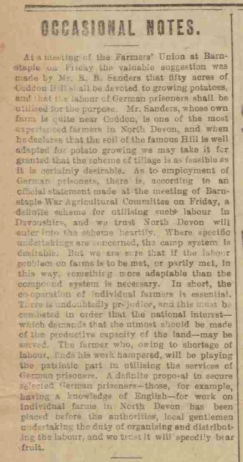
In contrast to the enticing Christmas food stuffs on offer, debate in the local press concerned the need for more potatoes to be grown with the suggestion that 50 acres of Codden Hill should be ploughed for this purpose. The Sports Ground and Pilton Park were also considered as locations by Barnstaple Town Council as well as the gardens of Ashleigh Road School. The suggestion of the Sports Ground was apparently “subject to a good deal of ridicule in the Market on Friday among farmers acquainted with the locality” with one expert saying that to break up the grassland was a waste of time and money and better suited to hay or grazing. The Council also suggested asking the Taw and Torridge Conservators to relax the restrictions on catching coarse fish in the river.
The employment of German prisoners was discussed at a meeting of the Barnstaple War Agricultural Committee and there were suggestions, by Barnstaple Farmers Union and Barnstaple Rural District Council respectively, that German prisoners of war be employed in planting the potatoes and also in quarrying.
Barnstaple Education Committee voted to pay bonuses to teachers for the duration of the War, the amount varying according to their present salary, marital status and number of children. These were to remain in place “for the duration of the War and for six months afterwards” but the article does not make clear the reasoning for this seemingly generous provision.
The tenants of properties in Corser Street, Barnstaple, formerly known as Boden’s Row, were to benefit from an improvement scheme by their new landlord, William Hutchings, whereupon the forty cottages were to be “converted into model dwellings. As the result a very striking and welcome transformation is being effected; and the enterprise of the public-spirited owner is eliciting general commendation.”
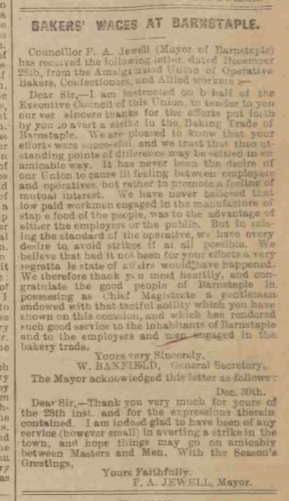 The Amalgamated Union of Operative Bakers, Confectioners and Allied Workers had written to the Mayor to offer their “very sincere thanks” for his efforts “to avert a strike in the Baking Trade of Barnstaple”. These had been successful and it was hoped that any “outstanding points of difference may be settled in an amicable way.” This pre-General Strike nod to deference and paternalism can also be seen in Earl Fortescue’s speech to the South Molton branch of the Devon Farmers Union, that they had not asked him there to sing Christmas carols, “rather that he should give them such counsel as he could as to the way to which they could best play their part in these anxious days.”
The Amalgamated Union of Operative Bakers, Confectioners and Allied Workers had written to the Mayor to offer their “very sincere thanks” for his efforts “to avert a strike in the Baking Trade of Barnstaple”. These had been successful and it was hoped that any “outstanding points of difference may be settled in an amicable way.” This pre-General Strike nod to deference and paternalism can also be seen in Earl Fortescue’s speech to the South Molton branch of the Devon Farmers Union, that they had not asked him there to sing Christmas carols, “rather that he should give them such counsel as he could as to the way to which they could best play their part in these anxious days.”
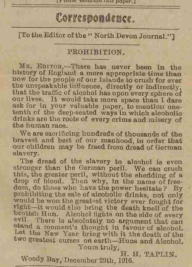
HH Taplin of Woody Bay wrote to the Journal concerned about “the unspeakable influence… that the traffic of alcohol has upon every sphere of our lives.” Arguing for the prohibition of the sale of alcoholic drinks, he continues -“the dread of the slavery to alcohol is even stronger that the German peril” and finishes – “let the New Year bring with it the death of the two greatest curses on earth – the Huns and Alcohol.”
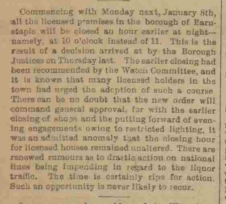
He would have been pleased to read that, as from January 8th, all the licensed premises in Barnstaple were to close one hour earlier, at 10pm rather than 11pm, to bring them into line with other premises which had had to adopt earlier closing times due to restricted lighting. This, presumably, was the cause of the “dark nights” mentioned in Hellier’s advertisement earlier.
The recently built Barnstaple Grammar School advertised a rather surprising curriculum for boys in that it included a shorthand class besides “classical and modern education, manual instruction” for boys. For younger readers, shorthand is a way of taking notes quickly in a form of hieroglyph, a dying art these days, but one which young women of the post ww2 decades were taught, alongside typing, as a popular career option. But perhaps office work was not seen as appropriate for girls in these earlier times, who were offered their own “specially suited for girls”curriculum of languages, literature, mathematics, botany, cookery and needlework.
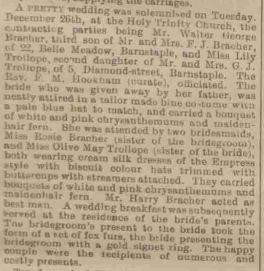 To finish on a celebratory note, Boxing Day weddings were not uncommon, even up until the 1950s, and in 1916 Walter Bracher and Lily Trollope had been married at Holy Trinity Church, Barnstaple. The bride “neatly attired in a tailor made blue costume with a pale blue hat to match” received a set of fox furs from the groom, to whom she gave, in return, a gold signet ring. The Journal comments that “the happy couple were the recipients of numerous and costly presents” – coming from Belle Meadow and Diamond Street respectively, not wealthy areas of the town, perhaps this was seen to be worthy of note.
To finish on a celebratory note, Boxing Day weddings were not uncommon, even up until the 1950s, and in 1916 Walter Bracher and Lily Trollope had been married at Holy Trinity Church, Barnstaple. The bride “neatly attired in a tailor made blue costume with a pale blue hat to match” received a set of fox furs from the groom, to whom she gave, in return, a gold signet ring. The Journal comments that “the happy couple were the recipients of numerous and costly presents” – coming from Belle Meadow and Diamond Street respectively, not wealthy areas of the town, perhaps this was seen to be worthy of note.
We hope that you have enjoyed this look at the past and that, despite imminent staffing changes, we will be able to continue our monthly blog postings throughout the next years to reflect the progress of the Great War.
At this time of year, of “peace and goodwill to all men”, it is particularly poignant to remember that this was supposed to be “the war to end all wars” – can we not learn the lessons from the past and stop repeating the same mistakes?
DG
Sources –
North Devon Journal – 20th December 1916 and 4th January 1917 – available to view in our Local Studies Centre at Barnstaple either on microfilm or via the British Newspaper Archive online which is free to use and download, (access may be unavailable at times due to subscription restrictions), your only cost being to pay for printouts.
1916 postcard image – https://www.worldwar1postcards.com/christmas-postcards.php
Share this with a friend who might be interested

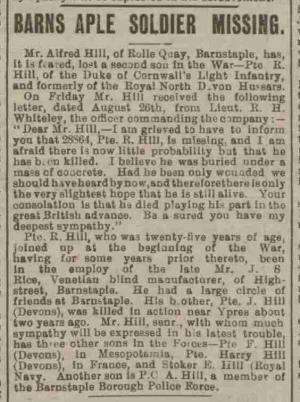 The snippet above appeared in the North Devon Journal on the 13th September 1917, the article alongside having appeared in the preceding week.
The snippet above appeared in the North Devon Journal on the 13th September 1917, the article alongside having appeared in the preceding week.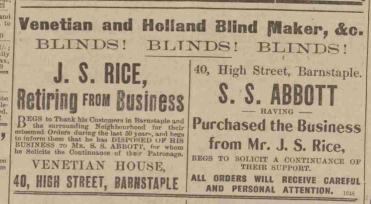
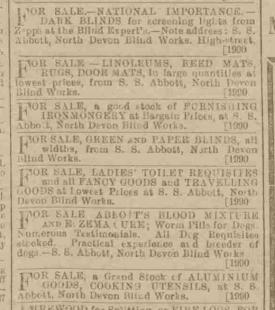 The article says that Private Hill had been employed by as a blind maker in the High Street. The shop fronts in Victorian and Edwardian photographs of the High Street are notable for the ubiquitous presence of blinds, which could be drawn out as a canopy to shade the windows. The blind making business of JS Rice had been taken over by SS Abbott in 1911 and by 1917 seems to have diversified into the supply of a variety of useful items – from dark blinds to screen “lights from Zepps” to “ladies’ toilet requisites” and “worm pills for dogs”.
The article says that Private Hill had been employed by as a blind maker in the High Street. The shop fronts in Victorian and Edwardian photographs of the High Street are notable for the ubiquitous presence of blinds, which could be drawn out as a canopy to shade the windows. The blind making business of JS Rice had been taken over by SS Abbott in 1911 and by 1917 seems to have diversified into the supply of a variety of useful items – from dark blinds to screen “lights from Zepps” to “ladies’ toilet requisites” and “worm pills for dogs”.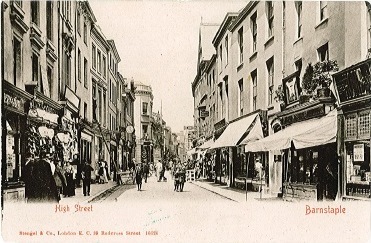
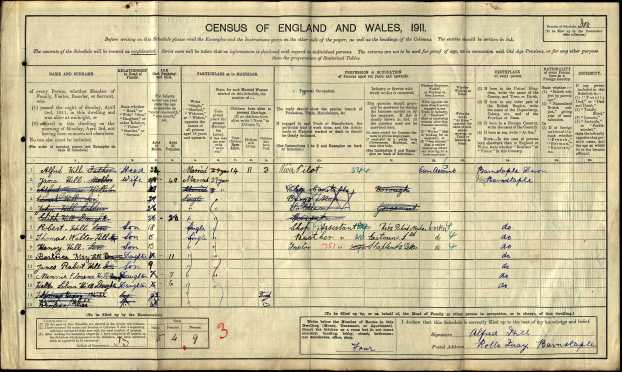

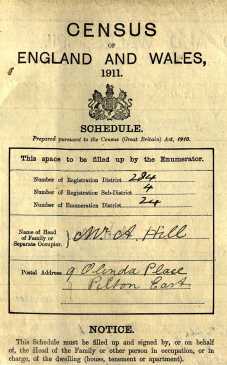
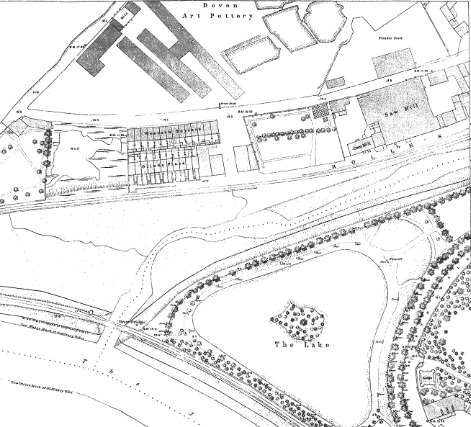
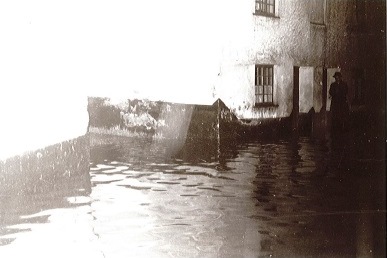
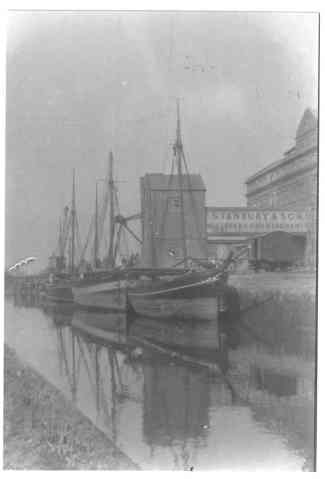
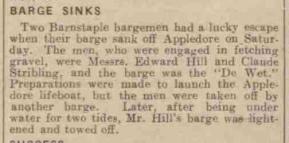
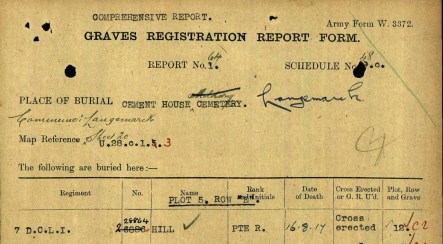
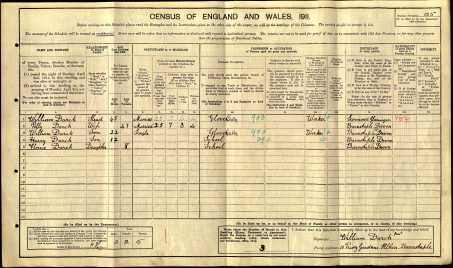
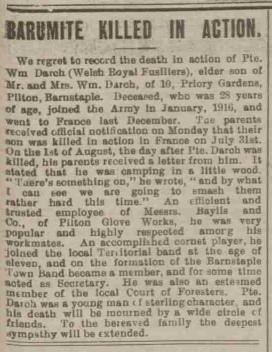 The North Devon Journal reports that, on the day after William’s death, his parents had received a letter from him saying that he was camping in a little wood and that there was “something on”.
The North Devon Journal reports that, on the day after William’s death, his parents had received a letter from him saying that he was camping in a little wood and that there was “something on”.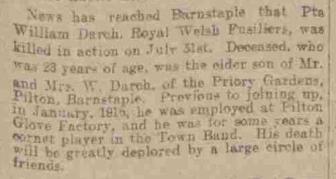
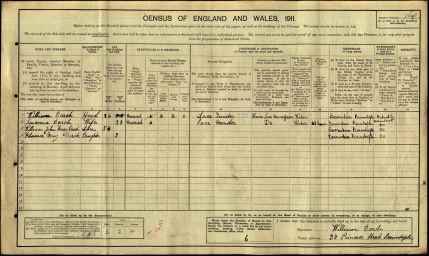
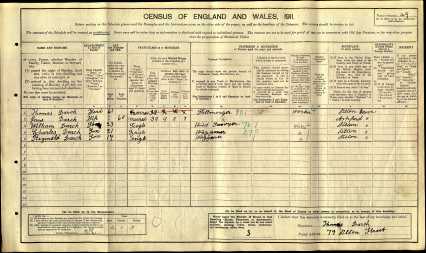
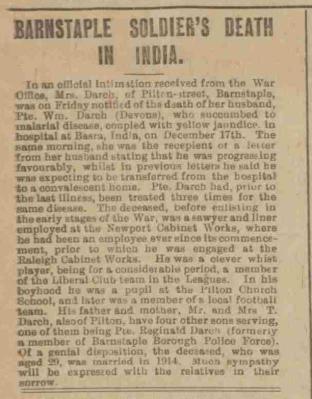
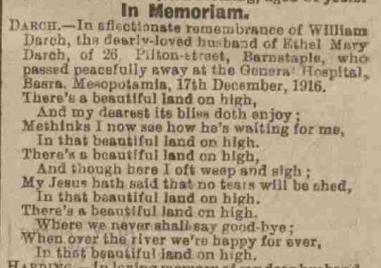


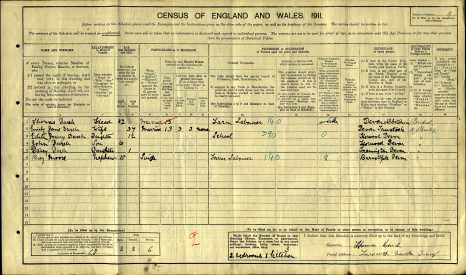

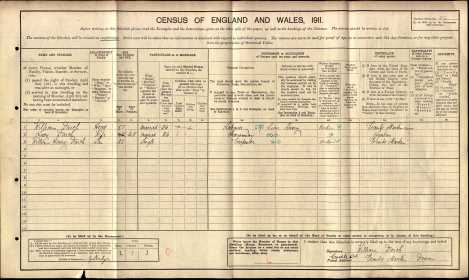
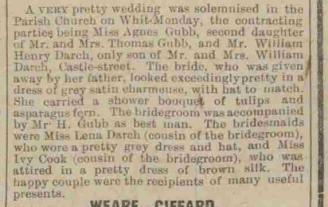 William was married in the village church on Whit Monday 1915 to Agnes Gubb, a local girl. As was usual at the time, the Journal article is very descriptive of the wedding attire – white dresses were not standard wear and so each event warranted a detailed account.
William was married in the village church on Whit Monday 1915 to Agnes Gubb, a local girl. As was usual at the time, the Journal article is very descriptive of the wedding attire – white dresses were not standard wear and so each event warranted a detailed account.


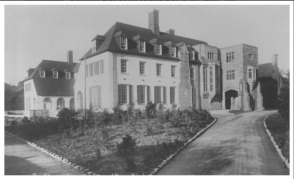
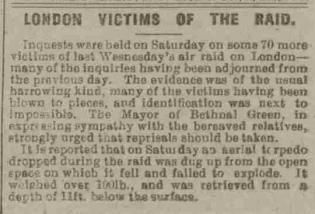
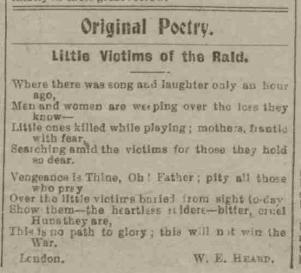 This next attack on the capital resulted in the deaths of 162 civilians, the highest death toll from a single air raid on Britain during WW1, and inspired the verse reproduced here in the North Devon Journal – the sentiment that bombing the innocent will not win wars resounds down the years but the lesson remains unlearned. A further attack, on 7th July, killed a further 57.
This next attack on the capital resulted in the deaths of 162 civilians, the highest death toll from a single air raid on Britain during WW1, and inspired the verse reproduced here in the North Devon Journal – the sentiment that bombing the innocent will not win wars resounds down the years but the lesson remains unlearned. A further attack, on 7th July, killed a further 57.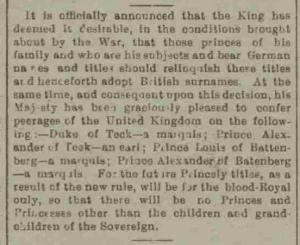 Meanwhile, the Royal Family had come to the decision to adopt more British sounding surnames, and at the same time, to restrict the titles of Prince and Princess to those in direct line to the throne. Existing princes and princesses were to be ennobled and so Prince Louis of Battenberg was to become a marquis, having been forced to resign as First Sea Lord, and being the father of Louis, later Earl Mountbatten.
Meanwhile, the Royal Family had come to the decision to adopt more British sounding surnames, and at the same time, to restrict the titles of Prince and Princess to those in direct line to the throne. Existing princes and princesses were to be ennobled and so Prince Louis of Battenberg was to become a marquis, having been forced to resign as First Sea Lord, and being the father of Louis, later Earl Mountbatten.

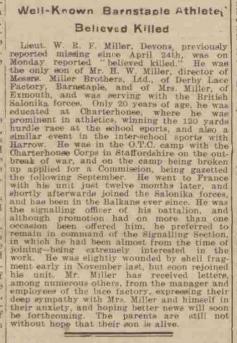 Among the death announcements in this week were those of George Henry Tucker of Northam, in Mesopotamia, and of Lieut William Reginald Francis Miller. Lieut Miller was the only son of William Miller, then living in Exmouth, who had followed his own father William Walter Miller as a director of the Derby Lace Factory. Lieut Miller had in fact died in action on the 25th of April that year and the Western Times reported that he was “believed killed” in May, noting that many employees of the lace factory had written to the parents to express their “deep sympathy … in their anxiety“.
Among the death announcements in this week were those of George Henry Tucker of Northam, in Mesopotamia, and of Lieut William Reginald Francis Miller. Lieut Miller was the only son of William Miller, then living in Exmouth, who had followed his own father William Walter Miller as a director of the Derby Lace Factory. Lieut Miller had in fact died in action on the 25th of April that year and the Western Times reported that he was “believed killed” in May, noting that many employees of the lace factory had written to the parents to express their “deep sympathy … in their anxiety“.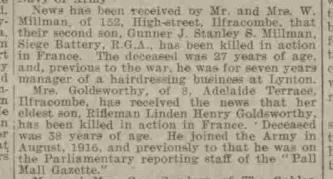 The deaths of Stanley Millman and Linden Goldsworthy of Ilfracombe were recorded in the Western Times. Both had been killed in action in France.
The deaths of Stanley Millman and Linden Goldsworthy of Ilfracombe were recorded in the Western Times. Both had been killed in action in France.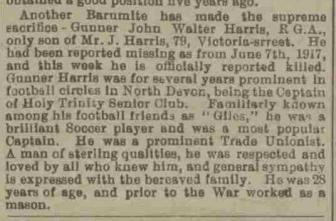 The death of John Walter Harris, who had been reported missing from the 7th of June, was not confirmed officially until the end of March 1918. What agonies his family must have gone through in the meantime can only be imagined. The memorial notice below was placed in the paper by his sisters in 1930.
The death of John Walter Harris, who had been reported missing from the 7th of June, was not confirmed officially until the end of March 1918. What agonies his family must have gone through in the meantime can only be imagined. The memorial notice below was placed in the paper by his sisters in 1930.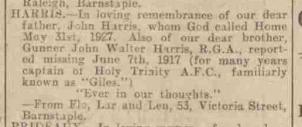
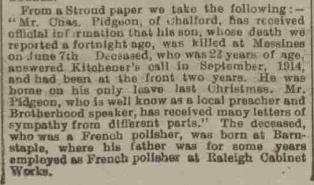
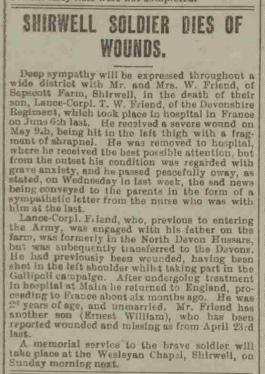
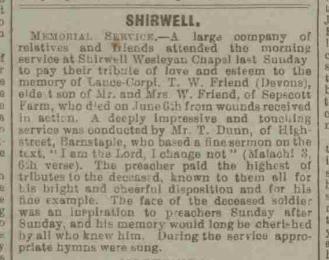



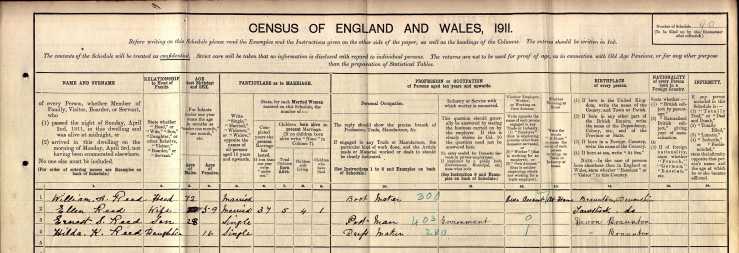




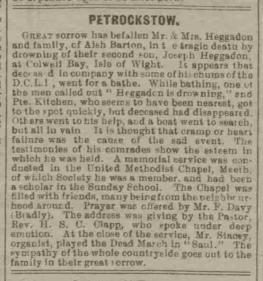
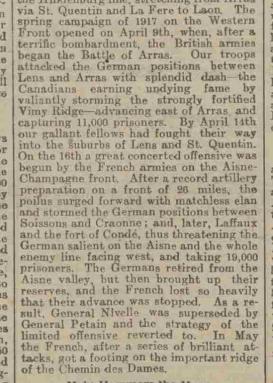 The article alongside is part of a summary of the progress of the War printed in the North Devon Journal in the January of 1918. Throughout the War there appear weekly updates on the campaigns in the various theatres of war as well as news of North Devon soldiers, both on the front and at home. One such weekly update, published on Thursday 10th May and written on the Friday of the previous week, is reproduced below.
The article alongside is part of a summary of the progress of the War printed in the North Devon Journal in the January of 1918. Throughout the War there appear weekly updates on the campaigns in the various theatres of war as well as news of North Devon soldiers, both on the front and at home. One such weekly update, published on Thursday 10th May and written on the Friday of the previous week, is reproduced below.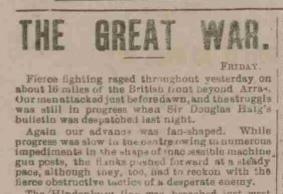
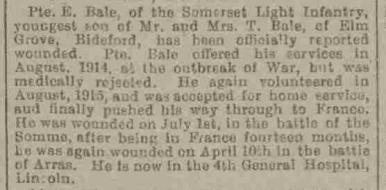
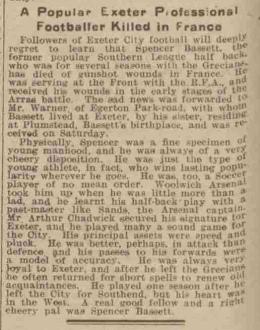
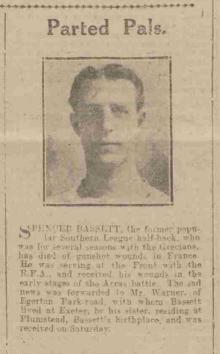
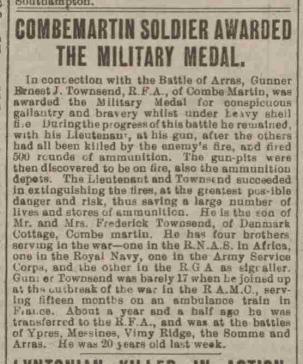
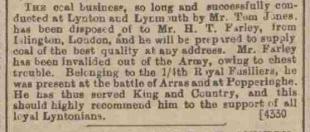 This article, from November 1917, almost asks for acceptance of an “incomer” to Lynton taking over a local coal business, on the grounds that he has served his country at Arras and Popperinghe.
This article, from November 1917, almost asks for acceptance of an “incomer” to Lynton taking over a local coal business, on the grounds that he has served his country at Arras and Popperinghe.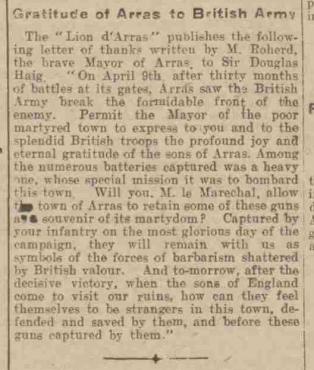
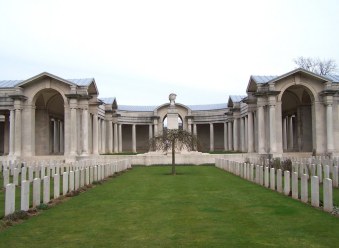

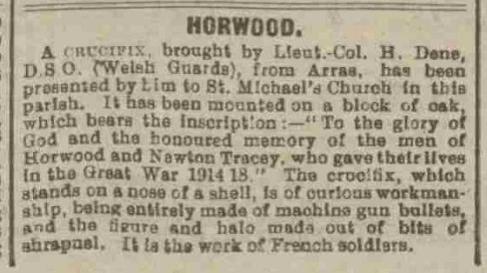
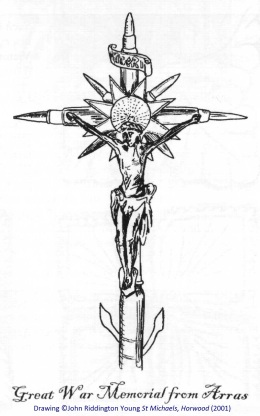
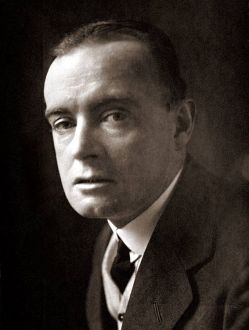

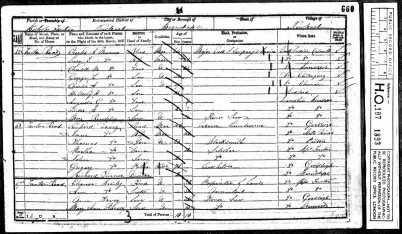
 In May of that year he had moved and the house at Chiv(e)nor was up for rent. However by 1870 he was selling furniture from his subsequent home at King’s Close, Newport – changes of address perhaps related to his Naval service.
In May of that year he had moved and the house at Chiv(e)nor was up for rent. However by 1870 he was selling furniture from his subsequent home at King’s Close, Newport – changes of address perhaps related to his Naval service.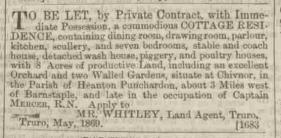
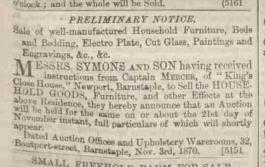


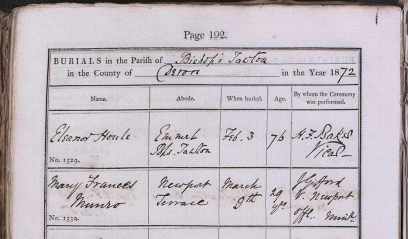 Mary is recorded in the Bishops Tawton burial register as having been resident at Newport Terrace, a group of Georgian houses near the bottom of Newport Road. Basil Northover, one of our local researchers, compiled a study of the residents of Newport Terrace from its being built up to the 2000s and we keep a manuscript copy in our Local Studies Centre. However this does not mention either the Munro or Mercer family in its index. It is not clear from the burial register at which number she was staying and there are some periods for which Basil Northover was unable to confirm the owner or tenant of a particular house, which may be the case here. It is possible that Lucy had moved here from her earlier address at Clarence Place.
Mary is recorded in the Bishops Tawton burial register as having been resident at Newport Terrace, a group of Georgian houses near the bottom of Newport Road. Basil Northover, one of our local researchers, compiled a study of the residents of Newport Terrace from its being built up to the 2000s and we keep a manuscript copy in our Local Studies Centre. However this does not mention either the Munro or Mercer family in its index. It is not clear from the burial register at which number she was staying and there are some periods for which Basil Northover was unable to confirm the owner or tenant of a particular house, which may be the case here. It is possible that Lucy had moved here from her earlier address at Clarence Place.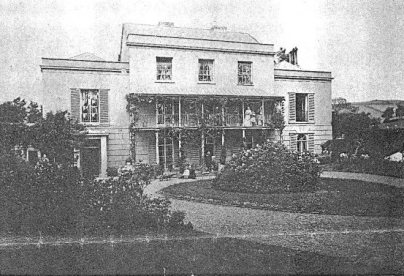
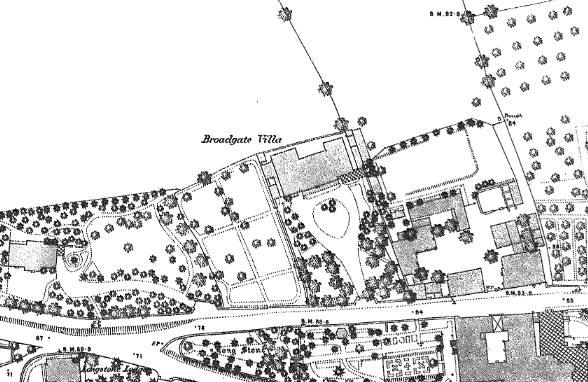
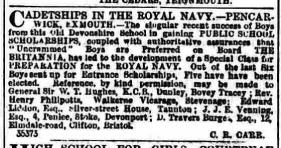 By 1893 Pencarwick was advertising its special class for preparation for the Royal Navy, based on “authoritative assurances that “uncrammed” boys are preferred on board the Britannia”.
By 1893 Pencarwick was advertising its special class for preparation for the Royal Navy, based on “authoritative assurances that “uncrammed” boys are preferred on board the Britannia”.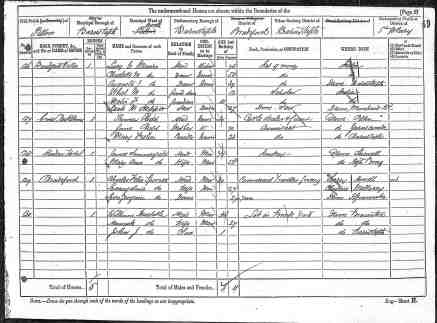 The head of the household at Broadgate Villa is Hector’s grandmother, Lucy Munro, and other occupants are a servant and the aunts, Charlotte ( known as Tom) and Augusta. These were the aunts who would find future fame, or infamy, in Saki’s short stories. Lucy died in 1882 and was also buried at Bishops Tawton, despite then living in Pilton. After this the house would be run by the aunts…
The head of the household at Broadgate Villa is Hector’s grandmother, Lucy Munro, and other occupants are a servant and the aunts, Charlotte ( known as Tom) and Augusta. These were the aunts who would find future fame, or infamy, in Saki’s short stories. Lucy died in 1882 and was also buried at Bishops Tawton, despite then living in Pilton. After this the house would be run by the aunts…
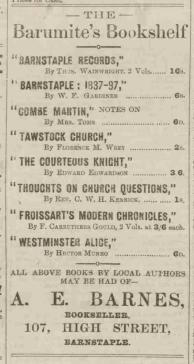 He then paired up with another who had grown up in Barnstaple, the caricaturist Francis Carruthers Gould, who illustrated his The Westminster Alice, a parody of political figures as characters from Lewis Carroll’s book. Gould presented a copy of their work to the North Devon Athenaeum in 1903, as reported in the North Devon Journal, and where reference is made to the pen name of Saki.
He then paired up with another who had grown up in Barnstaple, the caricaturist Francis Carruthers Gould, who illustrated his The Westminster Alice, a parody of political figures as characters from Lewis Carroll’s book. Gould presented a copy of their work to the North Devon Athenaeum in 1903, as reported in the North Devon Journal, and where reference is made to the pen name of Saki.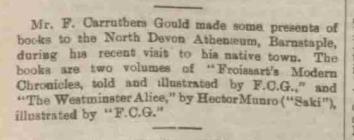
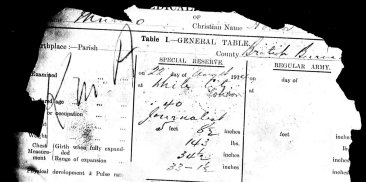

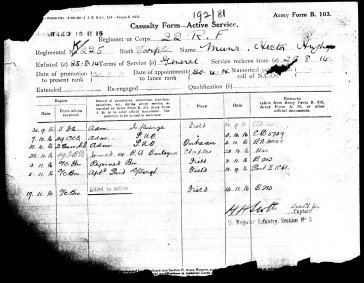
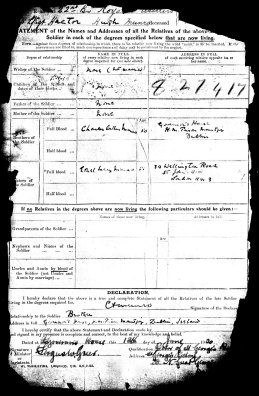
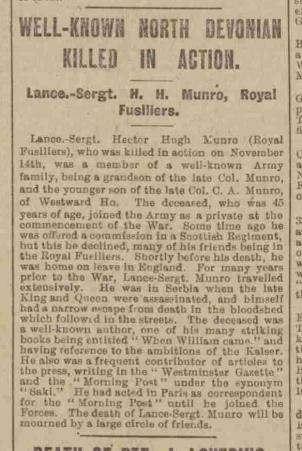
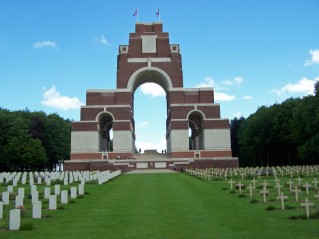



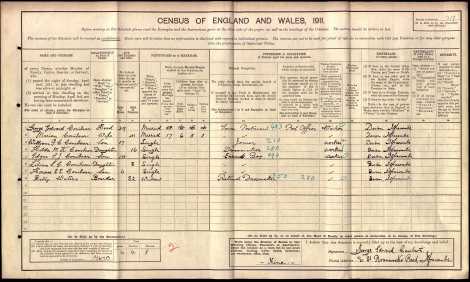
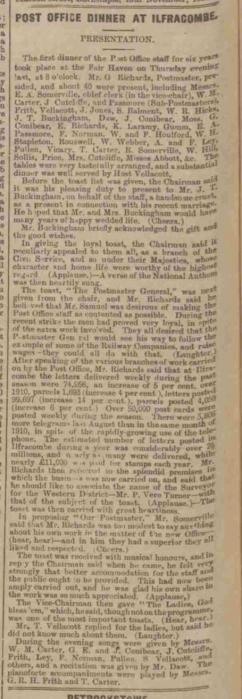
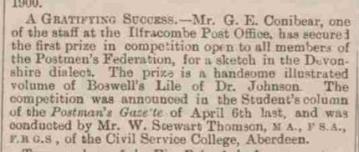
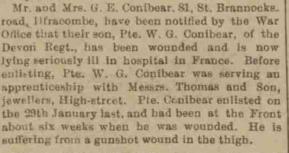


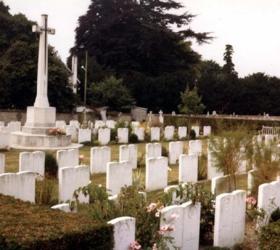
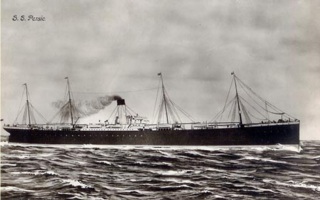
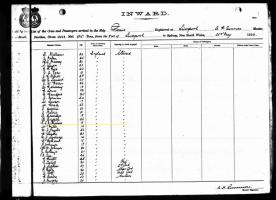

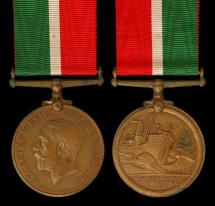
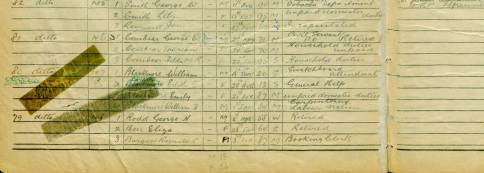


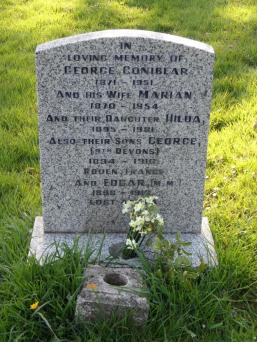 George died in 1951 and his wife Marian in 1954
George died in 1951 and his wife Marian in 1954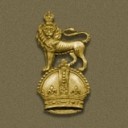 LEONARD MONTAGUE PASKEY
LEONARD MONTAGUE PASKEY 
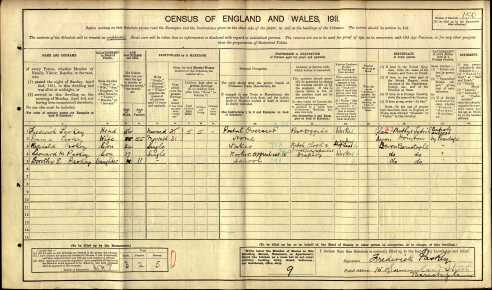

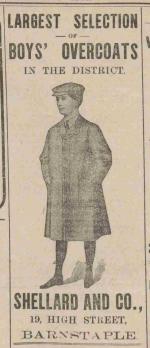 ‘Mr. and Mrs. F Paskey, of Summerland Street, Barnstaple, were on Friday officially notified that their son Pte. Leonard Paskey (Devons) previously reported missing, was killed in action or died of wounds in France about September 2nd. The deceased who was 24 years of age, served his apprenticeship with Messrs. Shellard and Co., of High Street Barnstaple. Joining the Royal North Devon Hussars, he saw service first in Egypt and Palestine, and latterly in France, where he had been since May last. He was a young man of noble and kindly attributes, being beloved by all who knew him. This is the third soldier Mr. Paskey (formerly for many years an esteemed overseer at Barnstaple Post Office) has lost in the Great War, and to him and his family in their latest sorrow the sympathy of the residents of a wide district will be extended in the fullest measure.’
‘Mr. and Mrs. F Paskey, of Summerland Street, Barnstaple, were on Friday officially notified that their son Pte. Leonard Paskey (Devons) previously reported missing, was killed in action or died of wounds in France about September 2nd. The deceased who was 24 years of age, served his apprenticeship with Messrs. Shellard and Co., of High Street Barnstaple. Joining the Royal North Devon Hussars, he saw service first in Egypt and Palestine, and latterly in France, where he had been since May last. He was a young man of noble and kindly attributes, being beloved by all who knew him. This is the third soldier Mr. Paskey (formerly for many years an esteemed overseer at Barnstaple Post Office) has lost in the Great War, and to him and his family in their latest sorrow the sympathy of the residents of a wide district will be extended in the fullest measure.’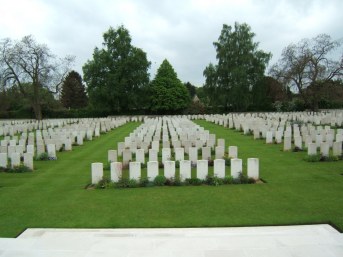
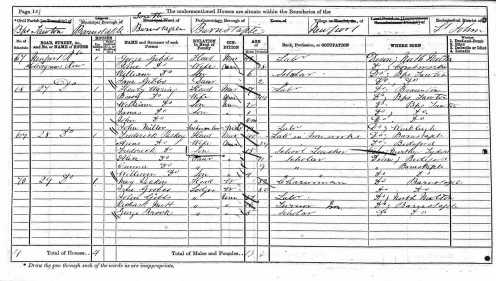
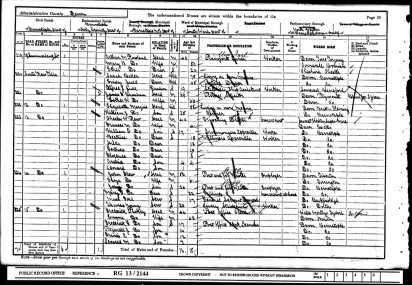
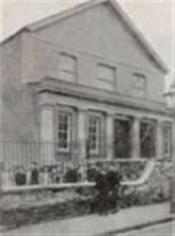
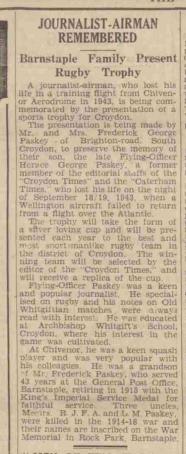 As a postscript, Frederick Paskey’s own son Horace attended Archbishop Whitgift’s School in Croydon and whilst there developed a love of rugby. He then went on to become a journalist, specialising in reporting on that sport, for the Croydon Times prior to joining the RAF to serve in World War Two. Horace was stationed at Chivenor and lost his life in a training sortie in 1943 when his Wellington failed to return from a flight over the Atlantic. The North Devon Journal reports that in 1946 his parents gave a silver trophy in his name to be awarded each year to”the best and most sportmanlike rugby team in the Croydon area” who would receive a replica to keep. The following year the death of Frederick Paskey is recorded in the March quarter of 1947 in the Croydon area. The 1939 Register records him as having been a “telegraphist – news”, whilst his daughter Doris is recorded as a “Sub Post Office clerk-in-charge”. It would seem that family connections had some influence in their occupations across the generations.
As a postscript, Frederick Paskey’s own son Horace attended Archbishop Whitgift’s School in Croydon and whilst there developed a love of rugby. He then went on to become a journalist, specialising in reporting on that sport, for the Croydon Times prior to joining the RAF to serve in World War Two. Horace was stationed at Chivenor and lost his life in a training sortie in 1943 when his Wellington failed to return from a flight over the Atlantic. The North Devon Journal reports that in 1946 his parents gave a silver trophy in his name to be awarded each year to”the best and most sportmanlike rugby team in the Croydon area” who would receive a replica to keep. The following year the death of Frederick Paskey is recorded in the March quarter of 1947 in the Croydon area. The 1939 Register records him as having been a “telegraphist – news”, whilst his daughter Doris is recorded as a “Sub Post Office clerk-in-charge”. It would seem that family connections had some influence in their occupations across the generations.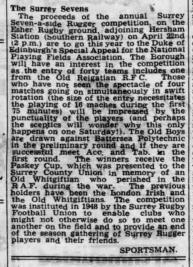
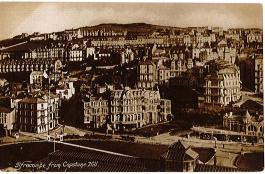
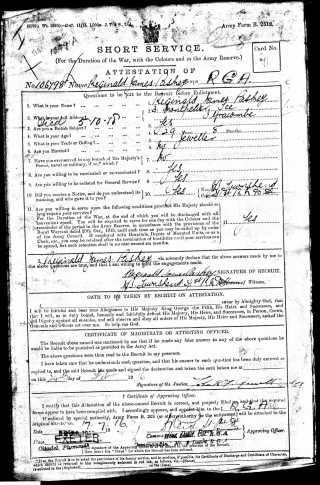

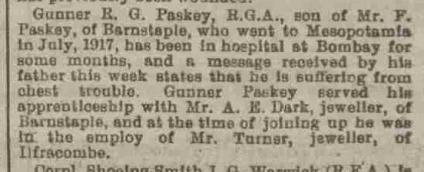
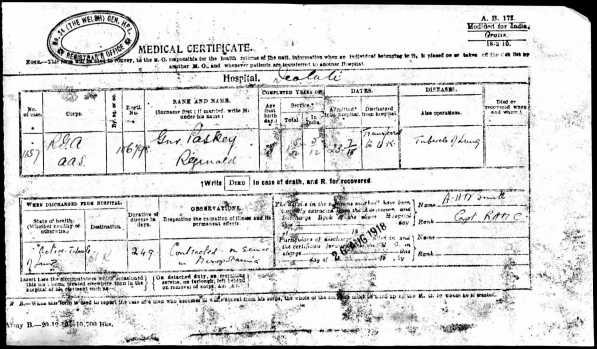
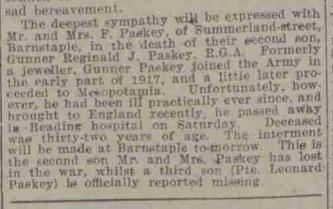 The next news on Reginald is then an article in Western Times reporting his death, dated the 9th October 1918 which reads: ’….Gunner Paskey joined the Army early in 1917 and a little later went to Mesopotamia. Unfortunately however he had been ill practically ever since, and brought to England recently, he passed away in Reading Hospital on Saturday.
The next news on Reginald is then an article in Western Times reporting his death, dated the 9th October 1918 which reads: ’….Gunner Paskey joined the Army early in 1917 and a little later went to Mesopotamia. Unfortunately however he had been ill practically ever since, and brought to England recently, he passed away in Reading Hospital on Saturday.
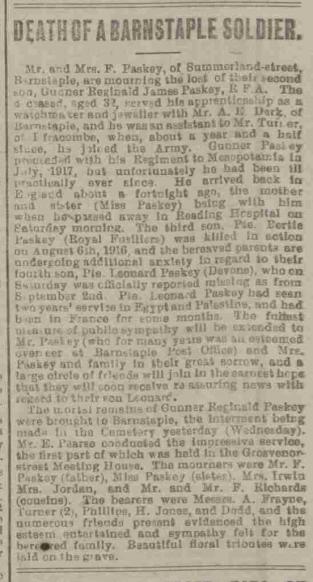 A further article in the North Devon Journal dated the 10th October 1918 reads as follows:
A further article in the North Devon Journal dated the 10th October 1918 reads as follows: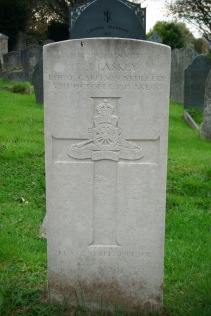 The mortal remains of Gunner Reginald Paskey were brought to Barnstaple, the interment being made in the cemetery yesterday (Wednesday)). Mr. E Pearse conducted the impressive service, the first part of which was held in the Grosvenor Street Meeting House. The mourners were Mr. F Paskey (father), Miss Paskey (sister), Mrs. Irwin, Mrs. Jordan and Mr. and Mrs. F Richards (cousins). The bearers were Messrs. A. Frayne, Turner (2), Philips, H Jones and Dodd, and the numerous friends present evidenced the high esteem entertained, and sympathy felt for the bereaved family. Beautiful floral tributes were laid on the grave.’
The mortal remains of Gunner Reginald Paskey were brought to Barnstaple, the interment being made in the cemetery yesterday (Wednesday)). Mr. E Pearse conducted the impressive service, the first part of which was held in the Grosvenor Street Meeting House. The mourners were Mr. F Paskey (father), Miss Paskey (sister), Mrs. Irwin, Mrs. Jordan and Mr. and Mrs. F Richards (cousins). The bearers were Messrs. A. Frayne, Turner (2), Philips, H Jones and Dodd, and the numerous friends present evidenced the high esteem entertained, and sympathy felt for the bereaved family. Beautiful floral tributes were laid on the grave.’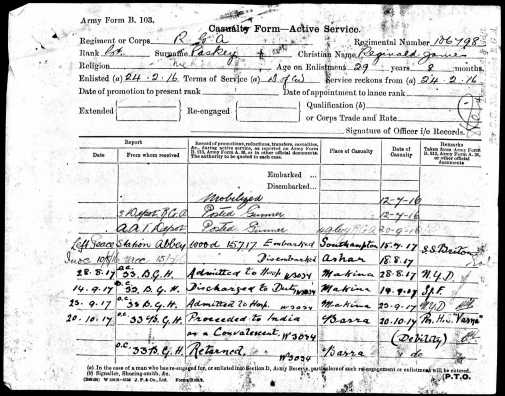
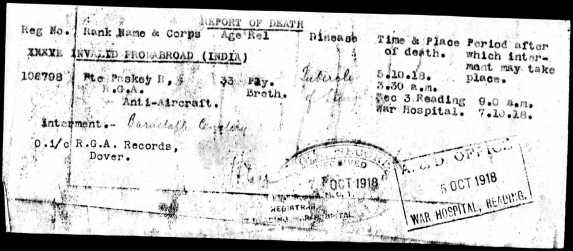
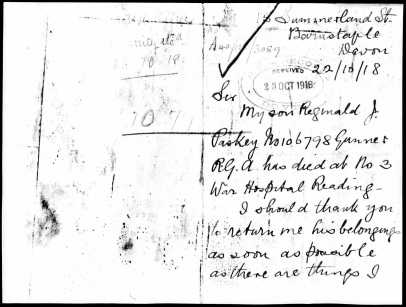
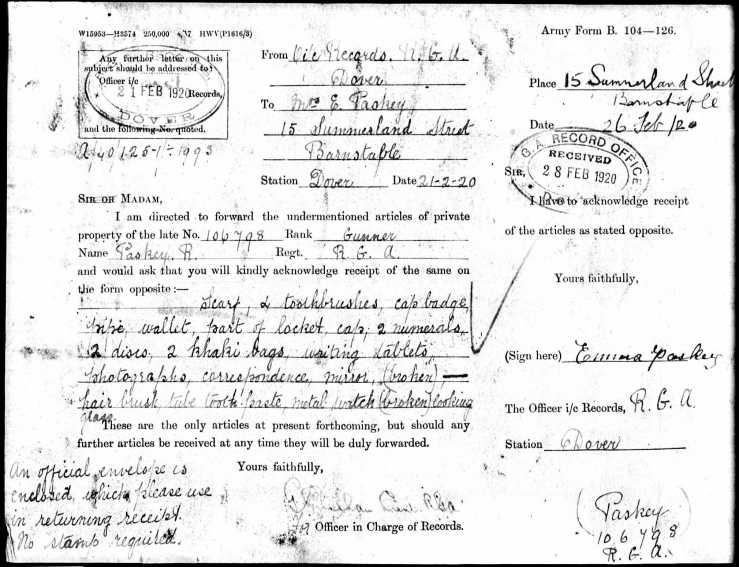
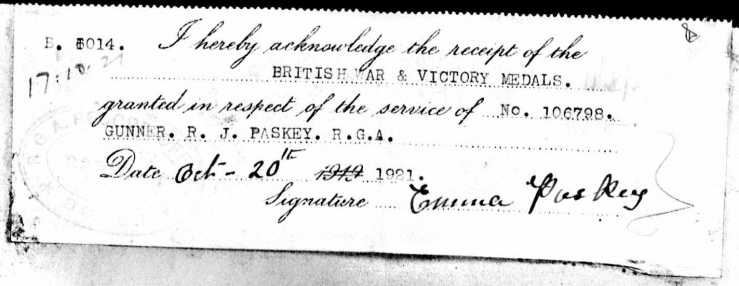


 Your Christmas fare could be obtained at a number of local businesses. Plum puddings and mincemeat, a large assortment of chocolates and crystallized fruit, prize cheddars, stiltons and swiss gruyere, ox tongues in tins and glass, could all be found at Chas Lock of 28 Boutport Street. “Home-made sausages, brawn and lard of the highest quality” could be found at A Frayne and Son, 34 Bear Street, pork purveyors, ham and bacon curers.
Your Christmas fare could be obtained at a number of local businesses. Plum puddings and mincemeat, a large assortment of chocolates and crystallized fruit, prize cheddars, stiltons and swiss gruyere, ox tongues in tins and glass, could all be found at Chas Lock of 28 Boutport Street. “Home-made sausages, brawn and lard of the highest quality” could be found at A Frayne and Son, 34 Bear Street, pork purveyors, ham and bacon curers. CC Dornat, North Devon Mineral Works, Tuly Street, Barnstaple offered “non-alcoholic high class cordials… a delicious substitute for ordinary intoxicating wines &c… possessing warming and invigorating qualities”. However, if you had “that creepy chilly feeling” or were feeling “stuffy in the head” you could obtain the Barum Cure from Frank Dyson, chemist of 26 Joy Street, Barnstaple.
CC Dornat, North Devon Mineral Works, Tuly Street, Barnstaple offered “non-alcoholic high class cordials… a delicious substitute for ordinary intoxicating wines &c… possessing warming and invigorating qualities”. However, if you had “that creepy chilly feeling” or were feeling “stuffy in the head” you could obtain the Barum Cure from Frank Dyson, chemist of 26 Joy Street, Barnstaple.


 Samuel Daw of 12 and 13 High Street suggested a Khaki Xmas, and the purchase of “military woollen half hose” or “warm pants or vests” among the ideas for “the man in khaki”. Walter J Thomas of 48 Boutport Street commended “something useful in these times”for men in the Services and a similar choice, including “sleeping helmets, mufflers, (and) spencers”, and sustenance in the form of Genoa Cake from Barnstaple Bakeries was mooted as”an ideal present for our boys at the Front”
Samuel Daw of 12 and 13 High Street suggested a Khaki Xmas, and the purchase of “military woollen half hose” or “warm pants or vests” among the ideas for “the man in khaki”. Walter J Thomas of 48 Boutport Street commended “something useful in these times”for men in the Services and a similar choice, including “sleeping helmets, mufflers, (and) spencers”, and sustenance in the form of Genoa Cake from Barnstaple Bakeries was mooted as”an ideal present for our boys at the Front”
 Entertainment on offer at the Theatre Royal consisted of the “special War Office picture – The King visits his armies in the Great Advance” four showings on Boxing Day and Wednesday.
Entertainment on offer at the Theatre Royal consisted of the “special War Office picture – The King visits his armies in the Great Advance” four showings on Boxing Day and Wednesday. The daily cost of the War was now a staggering “£ 5,710,000 including £400,000 daily in advances to Allies”. The total expenditure of the War for the year was said to have been £1,950,000,000, £350,000,000 more than had been the Budget estimate. Mr Bonar Law pointed out that the armies could not be kept at their present strength indefinitely and that all that could be hoped for was that they would be “kept on a strong figure long enough to beat our enemies” – an estimated figure of an extra 1,000,000 men for 1916/17 bringing the total to 5,000,000 is quoted.
The daily cost of the War was now a staggering “£ 5,710,000 including £400,000 daily in advances to Allies”. The total expenditure of the War for the year was said to have been £1,950,000,000, £350,000,000 more than had been the Budget estimate. Mr Bonar Law pointed out that the armies could not be kept at their present strength indefinitely and that all that could be hoped for was that they would be “kept on a strong figure long enough to beat our enemies” – an estimated figure of an extra 1,000,000 men for 1916/17 bringing the total to 5,000,000 is quoted. The effects of this mass mobilisation on families are illustrated by two brief articles. One records the death of 19 year old John Yeo, of Raleigh Park, at Aldershot, so probably in the Army, the fifth son of a family who had four sons in the Services. The other, a poignant note of sincere thanks by the three sons of the recently deceased FJ Tancock, neither of whom could attend their father’s funeral due to being on active service abroad.
The effects of this mass mobilisation on families are illustrated by two brief articles. One records the death of 19 year old John Yeo, of Raleigh Park, at Aldershot, so probably in the Army, the fifth son of a family who had four sons in the Services. The other, a poignant note of sincere thanks by the three sons of the recently deceased FJ Tancock, neither of whom could attend their father’s funeral due to being on active service abroad. Another sad loss, to Chittlehampton, was of Harold Woolaway of Coombe farm, who had been home in uniform only a fortnight previously but contracted measles and died in the Naval Hospital at Plymouth.
Another sad loss, to Chittlehampton, was of Harold Woolaway of Coombe farm, who had been home in uniform only a fortnight previously but contracted measles and died in the Naval Hospital at Plymouth.
 Mrs Darch of Pilton Street, heard of the death of her husband William from malarial disease and yellow jaundice in Basra. He had had the disease three times already and she had also received on the same morning, a letter from him saying that he was improving and to be transferred to a convalescent home. Aged 29 he had been married a few years but no children are mentioned. He did, however, have four other brothers serving.
Mrs Darch of Pilton Street, heard of the death of her husband William from malarial disease and yellow jaundice in Basra. He had had the disease three times already and she had also received on the same morning, a letter from him saying that he was improving and to be transferred to a convalescent home. Aged 29 he had been married a few years but no children are mentioned. He did, however, have four other brothers serving.

 WJ Buckley, serving with the Australian contingent, had just spent ten days leave from the French front with an uncle in Braunton. Only 19 years of age, he stood at 6ft 8 in and was also “splendidly developed”, his “extreme height attracting general attention” when he had been in Barnstaple on the Friday.
WJ Buckley, serving with the Australian contingent, had just spent ten days leave from the French front with an uncle in Braunton. Only 19 years of age, he stood at 6ft 8 in and was also “splendidly developed”, his “extreme height attracting general attention” when he had been in Barnstaple on the Friday. At home, a veteran of the Dardanelles, James Nunn of South Molton, who had been invalided out of service, had a narrow escape from drowning when he fell through the ice on a flooded lime pit at South Aller Farm after missing his footing while laying rabbit traps. “Suffering with cold and shock, he reached home in an exhausted condition, and has since been confined to his room”.
At home, a veteran of the Dardanelles, James Nunn of South Molton, who had been invalided out of service, had a narrow escape from drowning when he fell through the ice on a flooded lime pit at South Aller Farm after missing his footing while laying rabbit traps. “Suffering with cold and shock, he reached home in an exhausted condition, and has since been confined to his room”.
 The Amalgamated Union of Operative Bakers, Confectioners and Allied Workers had written to the Mayor to offer their “very sincere thanks” for his efforts “to avert a strike in the Baking Trade of Barnstaple”. These had been successful and it was hoped that any “outstanding points of difference may be settled in an amicable way.” This pre-General Strike nod to deference and paternalism can also be seen in Earl Fortescue’s speech to the South Molton branch of the Devon Farmers Union, that they had not asked him there to sing Christmas carols, “rather that he should give them such counsel as he could as to the way to which they could best play their part in these anxious days.”
The Amalgamated Union of Operative Bakers, Confectioners and Allied Workers had written to the Mayor to offer their “very sincere thanks” for his efforts “to avert a strike in the Baking Trade of Barnstaple”. These had been successful and it was hoped that any “outstanding points of difference may be settled in an amicable way.” This pre-General Strike nod to deference and paternalism can also be seen in Earl Fortescue’s speech to the South Molton branch of the Devon Farmers Union, that they had not asked him there to sing Christmas carols, “rather that he should give them such counsel as he could as to the way to which they could best play their part in these anxious days.”

 To finish on a celebratory note, Boxing Day weddings were not uncommon, even up until the 1950s, and in 1916 Walter Bracher and Lily Trollope had been married at Holy Trinity Church, Barnstaple. The bride “neatly attired in a tailor made blue costume with a pale blue hat to match” received a set of fox furs from the groom, to whom she gave, in return, a gold signet ring. The Journal comments that “the happy couple were the recipients of numerous and costly presents” – coming from Belle Meadow and Diamond Street respectively, not wealthy areas of the town, perhaps this was seen to be worthy of note.
To finish on a celebratory note, Boxing Day weddings were not uncommon, even up until the 1950s, and in 1916 Walter Bracher and Lily Trollope had been married at Holy Trinity Church, Barnstaple. The bride “neatly attired in a tailor made blue costume with a pale blue hat to match” received a set of fox furs from the groom, to whom she gave, in return, a gold signet ring. The Journal comments that “the happy couple were the recipients of numerous and costly presents” – coming from Belle Meadow and Diamond Street respectively, not wealthy areas of the town, perhaps this was seen to be worthy of note.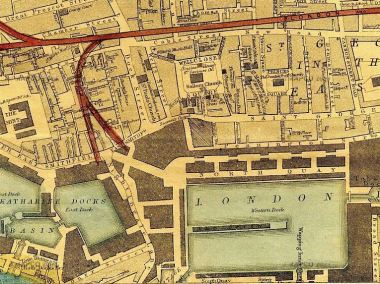 Albert Richard Peterson’s birth was registered in the Whitechapel District of London in 1876; he was the son of Henry Peterson and Hannah Dempsey who were married in the Tower Hamlets District of London in 1868.
Albert Richard Peterson’s birth was registered in the Whitechapel District of London in 1876; he was the son of Henry Peterson and Hannah Dempsey who were married in the Tower Hamlets District of London in 1868.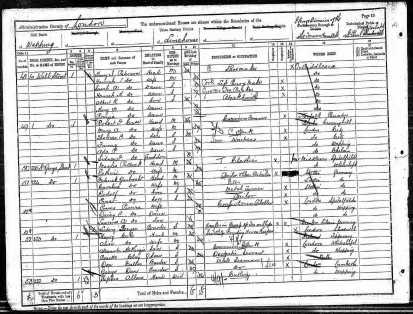
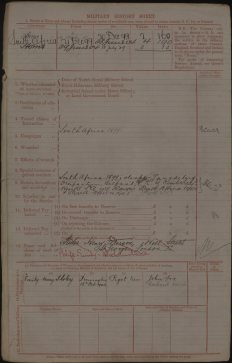 The next information found about Albert is an Attestation Order for enlisting in the Royal Artillery which he signed on 14th July 1897 where he stated he was 22 years and 5 months old and that he had served previously in the Royal Artillery but had purchased his discharge. The Anglo-Boer War records show his service number at that time to be 95037 and his rank as a Gunner in U Battery and also gives the information that on the 31st March 1900 he was listed as a prisoner of war at Koornspruit.
The next information found about Albert is an Attestation Order for enlisting in the Royal Artillery which he signed on 14th July 1897 where he stated he was 22 years and 5 months old and that he had served previously in the Royal Artillery but had purchased his discharge. The Anglo-Boer War records show his service number at that time to be 95037 and his rank as a Gunner in U Battery and also gives the information that on the 31st March 1900 he was listed as a prisoner of war at Koornspruit.
